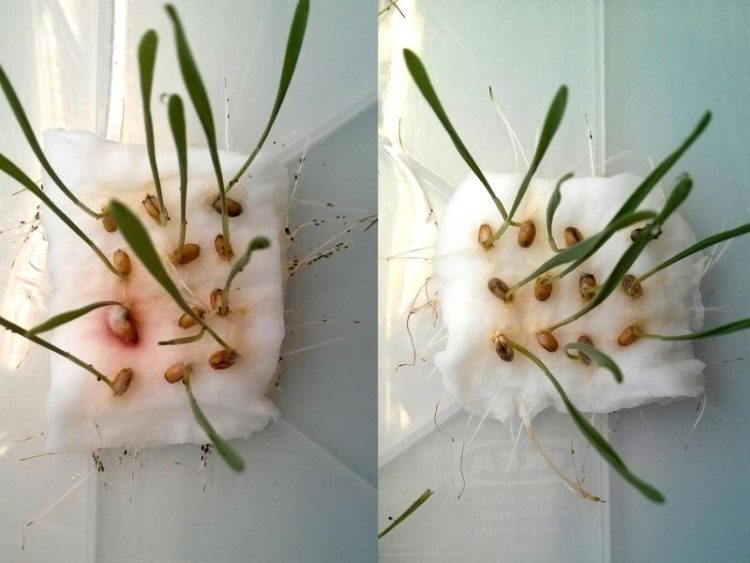Biodegradable crop protection products without risks or side effects

If aphids have the choice between wheat seedlings with (right) and without CBT-ol treatment (left), they avoid the treated seedlings. Images: W. Mischko / TUM
“It's not just about the bees, it's about the survival of humanity,” says Professor Thomas Brück, who heads the Werner Siemens Chair of Synthetic Biotechnology at TU Munich. “Without the bees that pollinate a wide variety of plants, not only would our supermarket shelves be quite bare, but within a short time, it would no longer be possible to supply the world's population with food.”
Synthetically produced insecticides endanger not only bees but also beetles, butterflies and grasshoppers. They affect biodiversity in soils, lakes, rivers and seas. Their use has consequently been highly controversial for many years.
Repelling instead of poisoning
Brück and his team have now found an alternative: The insect repellent they have developed is biodegradable and ecologically harmless. Sprayed on plants, it works much like mosquito repellent used by bathers in the summer, spreading a smell that keeps away unwanted insects.
“With our approach, we are opening the door to a fundamental change in crop protection,” says Brück. “Instead of spraying poison, which inevitably also endangers useful species, we deliberately merely aggravate the pests.”
Bacteria as chemical factories
The Munich researchers were inspired by the tobacco plant, which produces cembratrienol in its leaves, CBTol for short. The plant uses this molecule to protect itself from pests.
Using synthetic biotechnology tools, Professor Brück's team isolated the sections of the tobacco plant genome responsible for the formation of the CBTol molecules. They then built these into the genome of coli bacteria. Fed with wheat bran, a by-product from grain mills, the genetically modified bacteria now produce the desired active agent.
Efficiency in small and large scales
“The key challenge during production was to separate the active ingredients from the nutrient solution at the end of the process,” explains Mirjana Minceva, Professor of Biothermodynamics at the TUM Weihenstephan Campus.
The solution was centrifugal separation chromatography: a highly efficient process that works equally well on an industrial scale, but hitherto, had never been used to separate products from fermentation processes.
Equally effective against bacteria
Initial investigations indicate that the CBTol spray is non-toxic to insects, yet still protects against aphids. Since it is biodegradable, it does not accumulate.
In addition, the bioactivity tests showed that cembratrienol has an antibacterial effect on gram-positive bacteria. It can thus be used as a disinfectant spray that acts specifically against pathogens such as Staphylococcus aureus (MRSA pathogen), Streptococcus pneumoniae (pneumonia pathogen) or Listeria monocytogenes (listeriosis pathogen).
Publication
Wolfgang Mischko, Max Hirte, Simon Roehrer, Hannes Engelhardt, Norbert Mehlmer, Mirjana Minceva and Thomas Brück
Modular Biomanufacturing for a Sustainable Production of Terpenoid-based Insect Deterrents
Green chemistry, May 14, 2018 – DOI: 10.1039/C8GC00434J
http://pubs.rsc.org/en/content/articlelanding/2018/gc/c8gc00434j#!divAbstract
Further information:
The project was funded by the Bavarian Ministry of Economic Affairs, Energy and Technology and the Werner Siemens Foundation. The research team used the equipment pool of the TUM Center for Industrial Biotechnology in Garching to do the technical scaling and validation of the cembratrienol production. The bioactivity tests were carried out in the Department of Biochemical Engineering of the Friedrich Alexander University Erlangen-Nürnberg.
Contact
Prof. Thomas Brück
Technical University of Munich
Werner Siemens Chair of Synthetic Biotechnology
Lichtenbergstr. 4, 85748 Garching, Germany
Tel.: +49 89 289 13253 – E-mail: brueck@tum.de
Web: http://www.wssb.ch.tum.de/
https://www.tum.de/nc/en/about-tum/news/press-releases/detail/article/34679/ Link to the press release
Media Contact
All latest news from the category: Life Sciences and Chemistry
Articles and reports from the Life Sciences and chemistry area deal with applied and basic research into modern biology, chemistry and human medicine.
Valuable information can be found on a range of life sciences fields including bacteriology, biochemistry, bionics, bioinformatics, biophysics, biotechnology, genetics, geobotany, human biology, marine biology, microbiology, molecular biology, cellular biology, zoology, bioinorganic chemistry, microchemistry and environmental chemistry.
Newest articles

NASA: Mystery of life’s handedness deepens
The mystery of why life uses molecules with specific orientations has deepened with a NASA-funded discovery that RNA — a key molecule thought to have potentially held the instructions for…

What are the effects of historic lithium mining on water quality?
Study reveals low levels of common contaminants but high levels of other elements in waters associated with an abandoned lithium mine. Lithium ore and mining waste from a historic lithium…

Quantum-inspired design boosts efficiency of heat-to-electricity conversion
Rice engineers take unconventional route to improving thermophotovoltaic systems. Researchers at Rice University have found a new way to improve a key element of thermophotovoltaic (TPV) systems, which convert heat…



